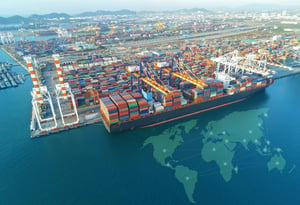In today's commercial environment, adhering to rules of origin and compliance has never been more crucial, especially for companies operating within North America under the USMCA.
In today's commercial environment, adhering to rules of origin and compliance has never been more crucial, particularly for companies operating within North America under the USMCA. As nearshoring and the evolving trade dynamics reshape the region's supply chains, ensuring compliance with these regulations is vital for businesses to capitalize on the trade agreement's benefits. By adhering to rules of origin, companies can qualify for preferential tariff treatment, enhance supply chain efficiency, and maintain competitiveness in a market increasingly driven by regional integration and nearshoring strategies. With the growing emphasis on North American manufacturing and trade, strict compliance has become a cornerstone for success in this evolving landscape.
This is the third blog which is part of “The Nearshoring Series” summarizing some of the key conversations I have had with important stakeholders in recent months.
Today I want to delve in the necessity that is particularly evident in strategic sectors like the automotive industry, where regional rules and standards aim to ensure a level playing field for all participants.
USMCA Made for Nearshoring
Broadly, the USMCA creates a baseline for North America as a key platform for building complete supply chains in areas such as electric vehicles (EVs) and semiconductors, as well as address and advance strategic climate initiatives.

Source – U.S. Congressional Research Service
Read more about North America's transition to electric vehicles and download the free e-book.

Source – https://www.brookings.edu/articles/usmca-at-3-reflecting-on-impact-and-charting-the-future/
Evolving Trade: the Concern for China
However, policies that affect operational compliance are not the only focus that warrants our attention. Growing concern surrounds Chinese investments in critical areas such as technology and communications. The United States has adopted a selective approach, prioritizing transparency and adherence to market rules. This is evidenced by recent tariffs imposed by the U.S. and Mexico, aimed at protecting strategic, regional markets and promoting nearshoring as a solution to reduce reliance on foreign supply chains. This stance calls for prudence and detailed analysis of the long-term impacts of such investments on the region's security and technological innovation.
Supporting the Case for Nearshoring
As China's economy continues to grow and expand globally, so does their desire to invest in foreign markets, including North America. While this investment can bring economic benefits, there are also concerns about the potential impacts on national security and local industries. These concerns have made nearshoring initiatives increasingly relevant, as they allow North American countries to build more self-reliant supply chains and mitigate risks associated with foreign influence. Chinese companies have been acquiring large stakes in various industries such as real estate, technology, and energy, raising concerns about their influence and control over strategic sectors.
Increasing Chinese Tariffs
Both the U.S. and Mexico have imposed import tariffs on certain goods. Many of these sectors are key to the Biden administration’s plans to reshore manufacturing, encourage nearshoring, and increase supply chain resilience to improve the political economy of the energy transition.

Source – https://www.visualcapitalist.com/comparing-new-and-current-u-s-tariffs-on-chinese-imports/
In the case of Mexico, the country has established temporary import tariffs ranging from 5% to 50% for 544 HS codes, including items such as steel, aluminum, textiles, apparel, footwear, wood, plastic, chemicals, ceramics, wood, glass, electrical material, furniture, among many others.
I call this the principle of clarity and transparency "playing by the rules", emphasizing it as a fundamental requirement for China if it seeks active participation in the North American market. This principle is not one-sided; similarly, other countries are expected to respect regulations when investing in China, promoting a fair and equitable competitive environment.
Nearshoring Opportunities
This context places us at the dawn of a new era in international trade relations, marked by a thorough review of how foreign investments, particularly Chinese, are perceived and managed. The strategic discussions and actions taking place, led by the United States and supported by other economic players, reflect the pursuit of a balance between economic openness, the protection of national strategic interests, and the growing shift toward nearshoring to strengthen regional supply chains.
In conclusion, we face a challenging yet equally opportunistic landscape. The ability to adapt to these new dynamics, including embracing nearshoring strategies, respecting the rules, and promoting transparency, will define the success of companies and economies in the modern era of international trade.
Blog post redacted from recent conversations about nearshoring in different media outlets, part of the “Nearshoring Series”.
If you are considering investing in North America, our nearshoring trade compliance services can add value to your analysis.






